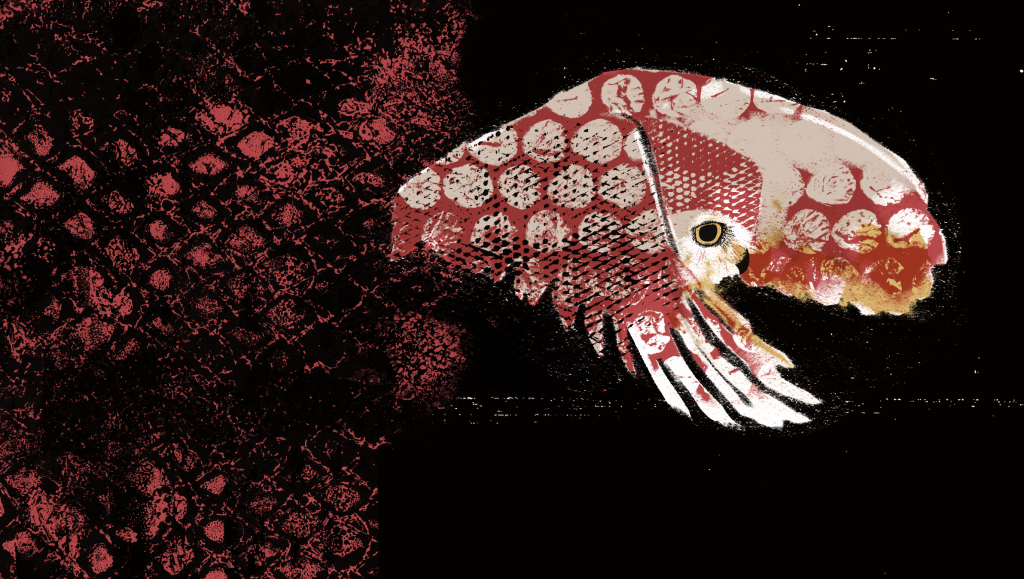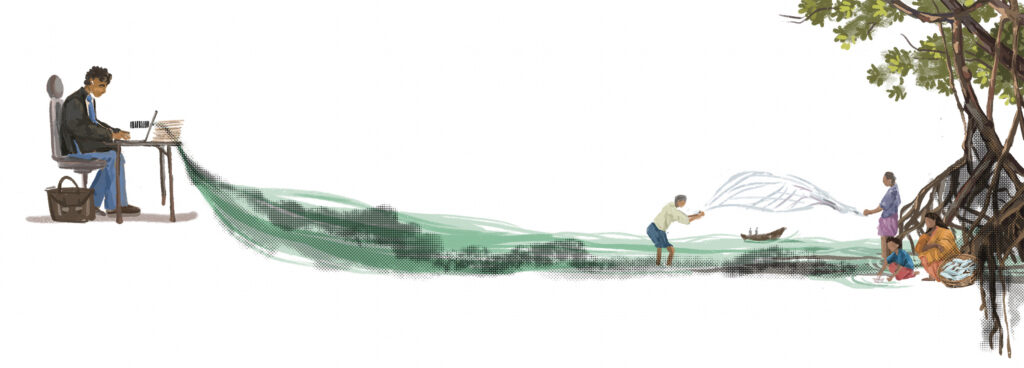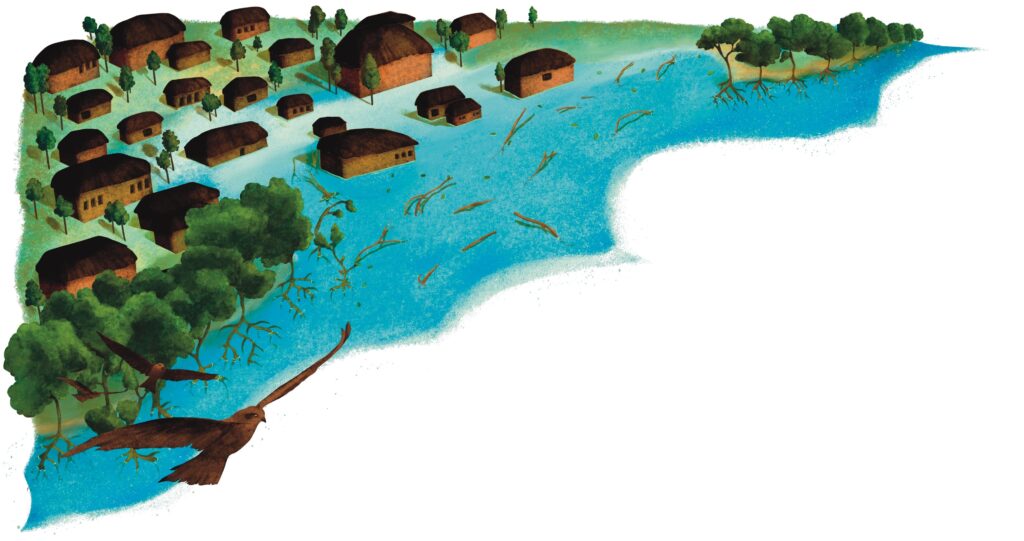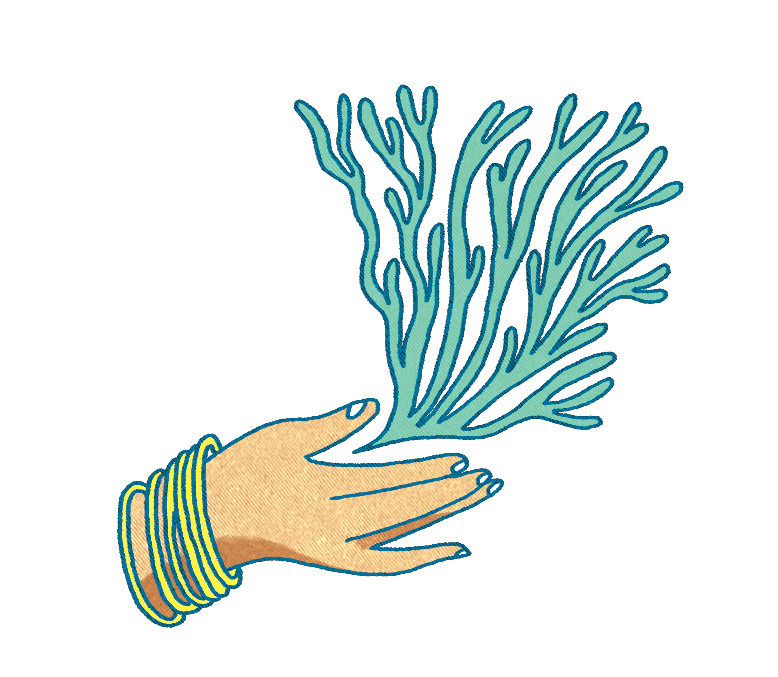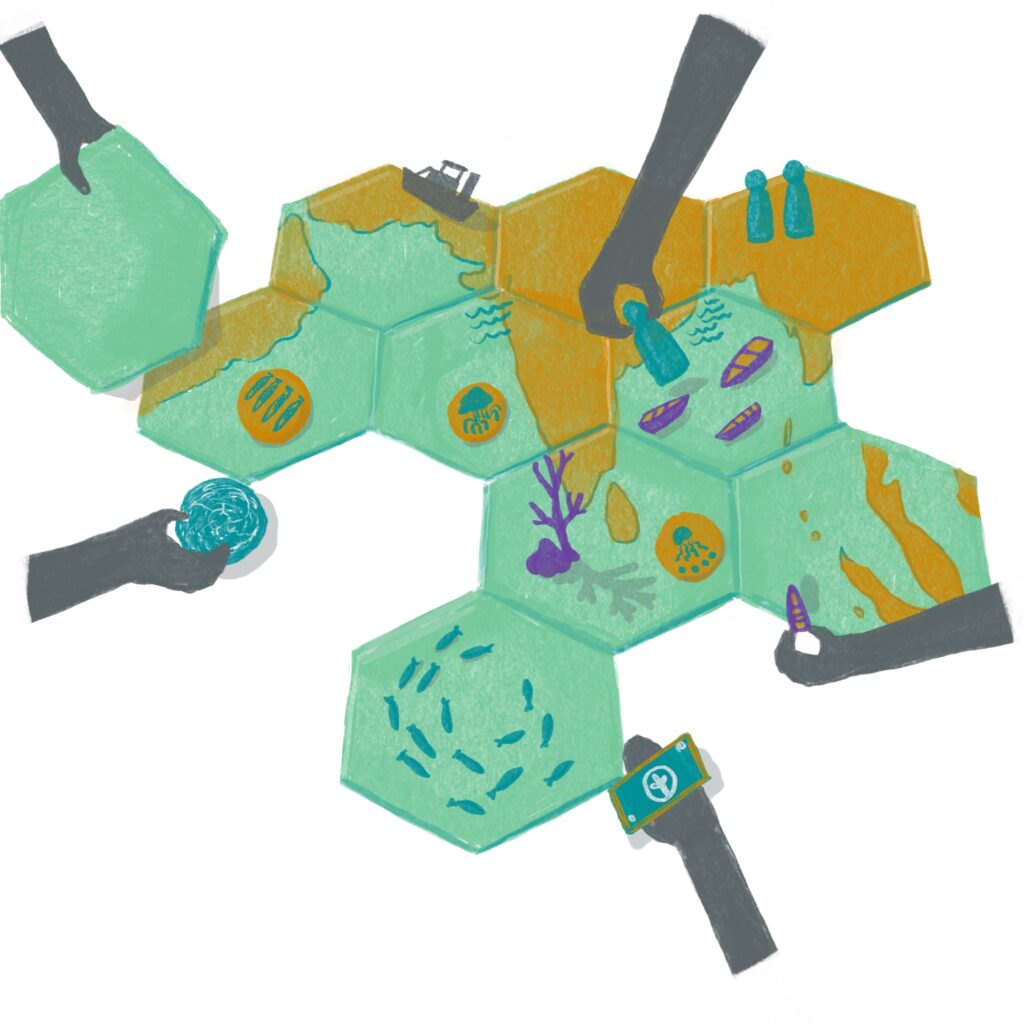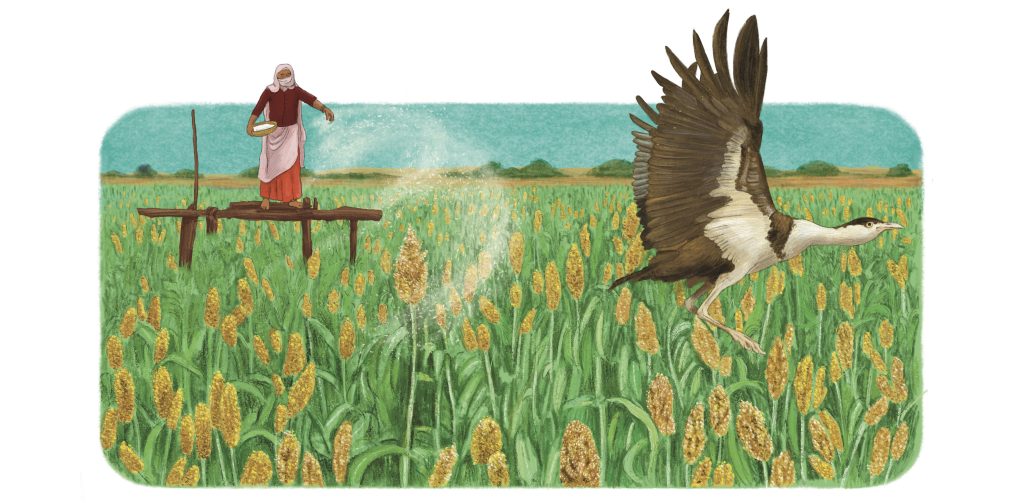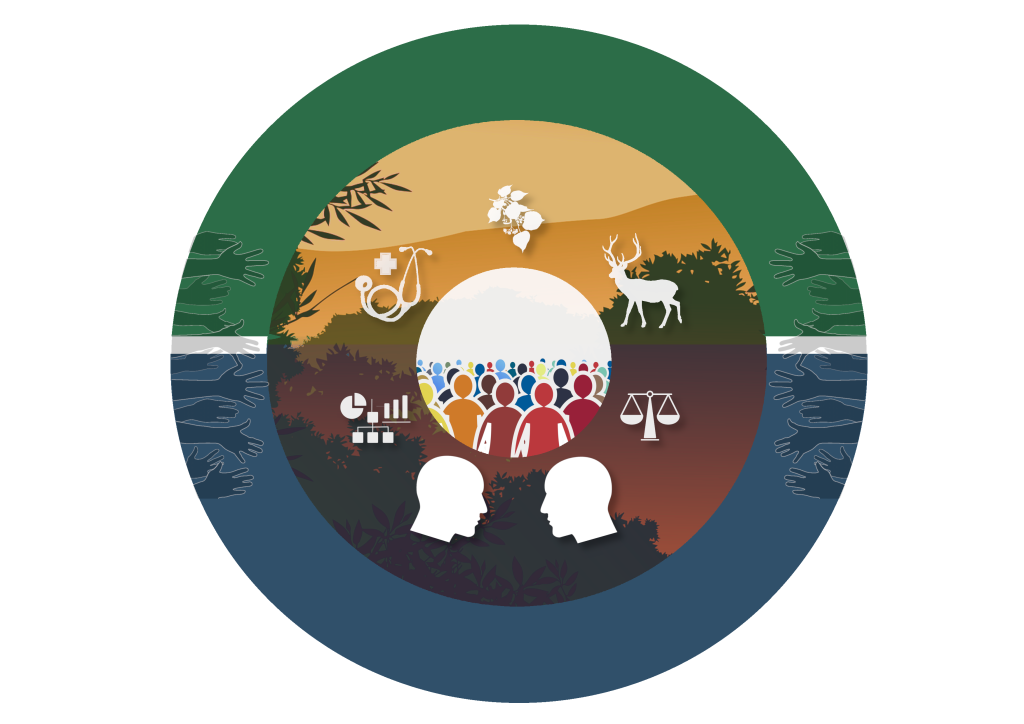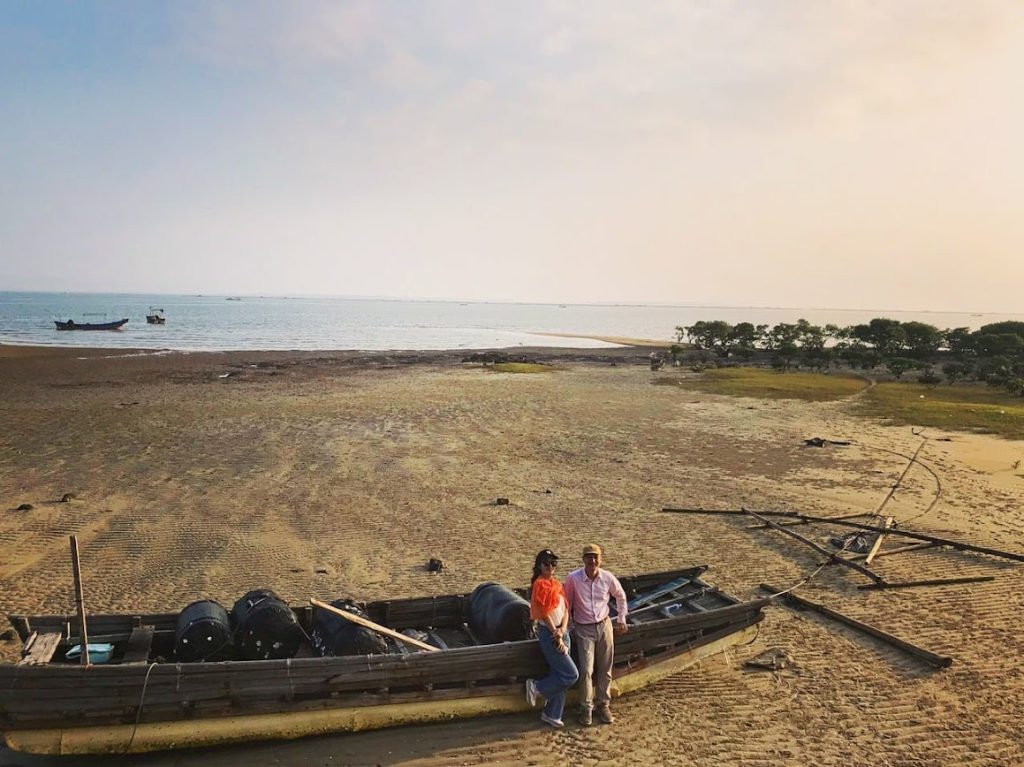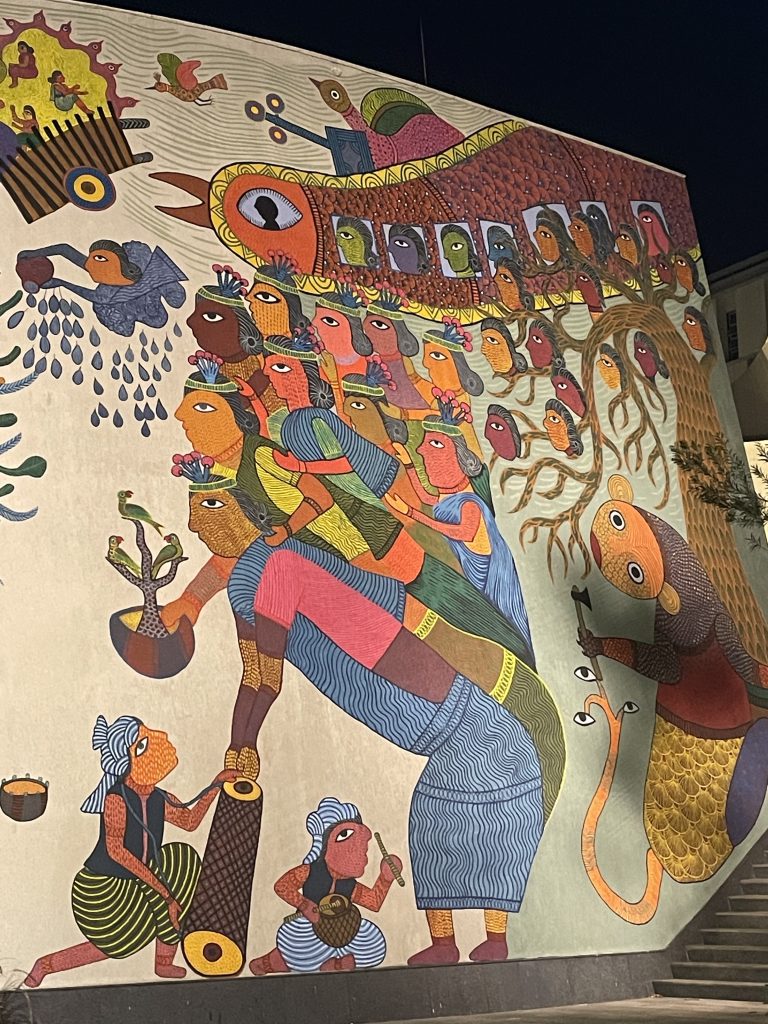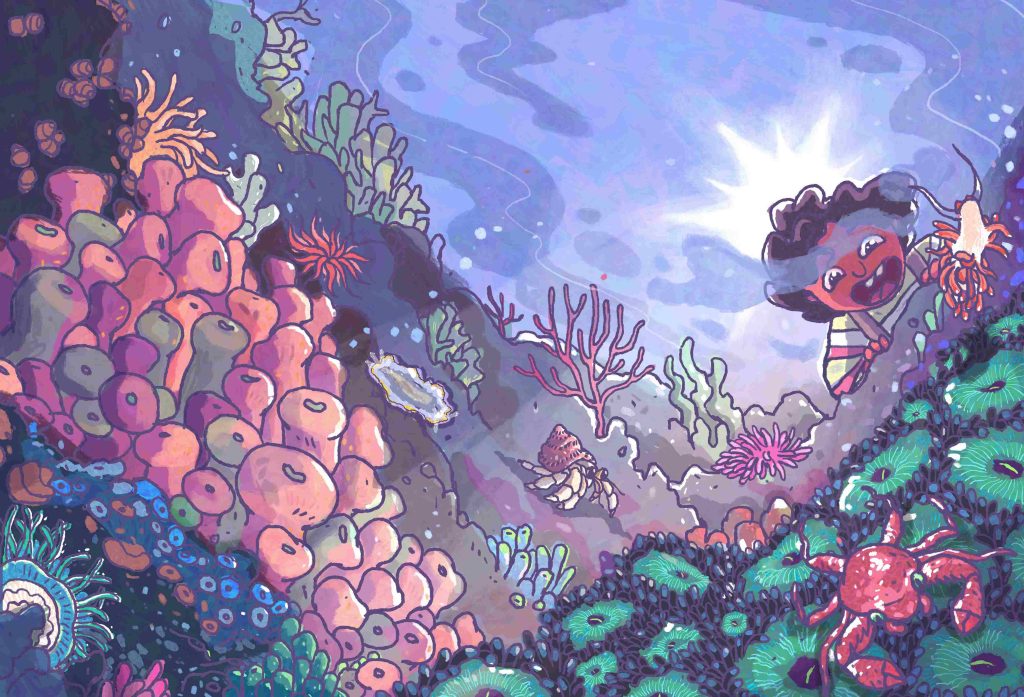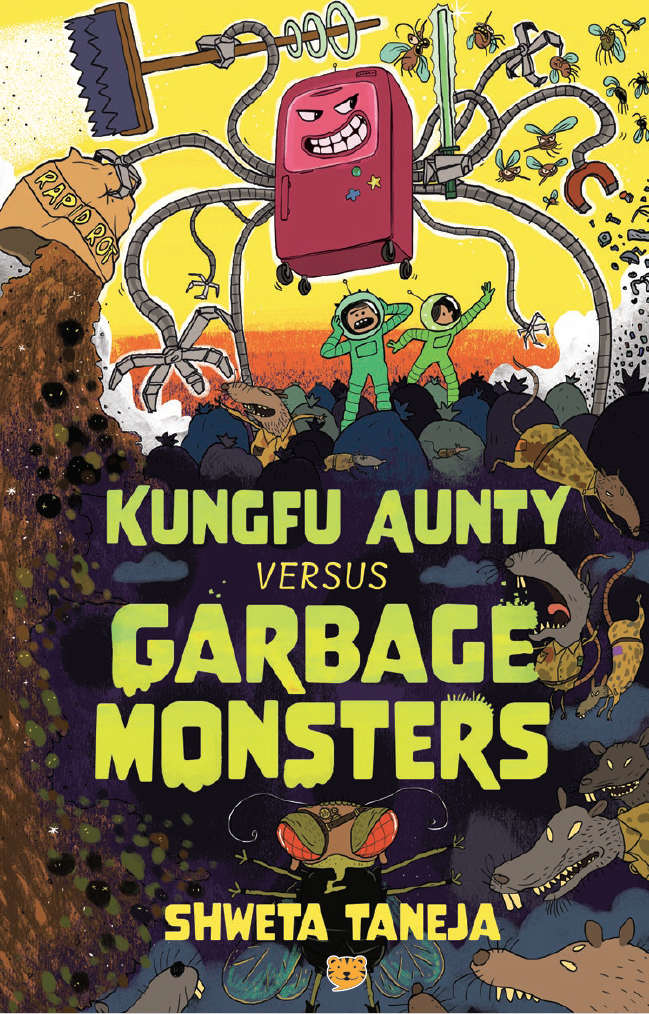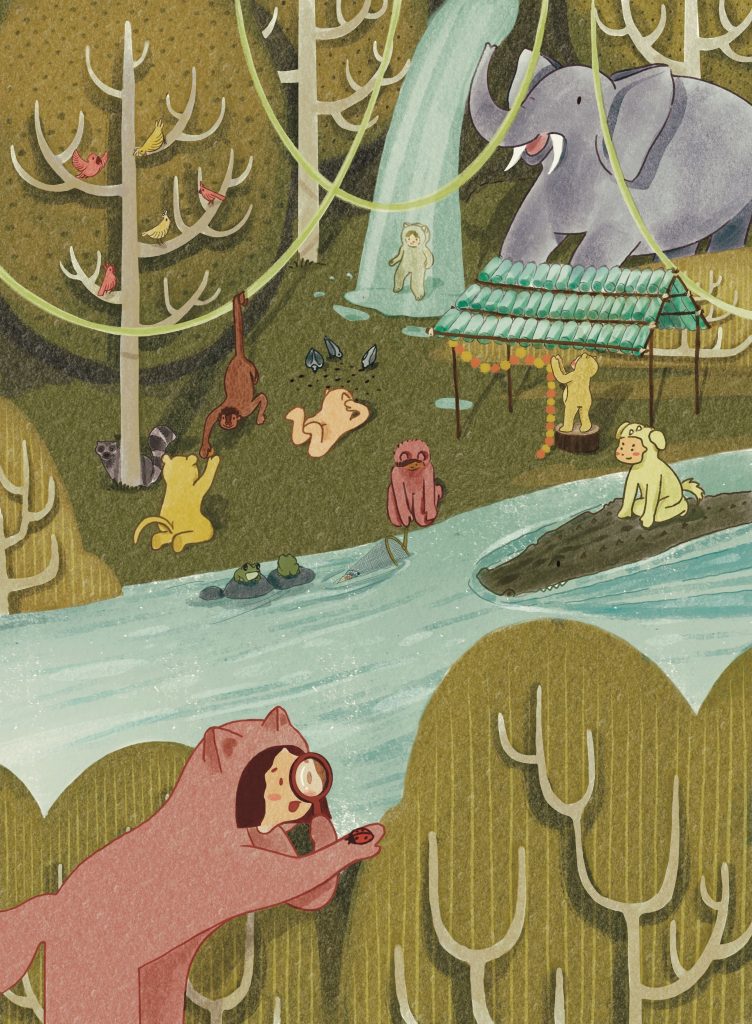‘Power lines’ is the underlying theme of this issue of Current Conservation. There might be a direct reference to these words only in one article, but the message runs across several other contributions. The discussion of Palacin et al’s 2016 paper narrates how birds struggle to navigate electricity lines disrupting their migratory routes. These tensions of the Great Bustard in Spain are not too far behind from what is happening in a prime tiger habitat in India. The country’s first experimental river interlinking project is out to fragment and submerge parts of Panna Tiger Reserve, says Joanna Van Gruisen’s in-depth understanding of the Ken-Betwa project.
Eben Goodale takes the discussion forward to highlight how conservation science needs to communicate with those affected or likely to be affected by the practice of conservation. The need for conservationists to engage with the politics of place is one message there. Caitlin Knight’s piece marches for science with it suggesting that science is so much a part of life that it is imperative for scientists not to engage with both society and policy. There is one contribution, which take us away from the anxieties that contemporary conservation practice has to encounter. It is the review of
the book Cheats and Deceits by Martin Stevens. It’s not humans, but wildlife here that are using an “array of techniques… to further their own agendas.” Finally, we carry an obituary of the environmentalist Duleep Mathai, whose foundation (DMNCT) has supported CC since its inception.
Editor: Kanchi Kohli
Month: June 2017
donate
Conservation is for everyone, and we help you understand it.
Donate

We can look at oceans in many different ways: as a vibrant ecosystem, a medium for trade and travel, a sink for carbon, a vast space of uncertainty and danger, or – as we will do here – a provider of food and livelihood. After all, oceans play a vital role in providing human society with income and nutritious food. However, as we argue in this paper, the contributions of fisheries to food security are increasingly undermined by a set of powerful trends.
Estimates suggest that, worldwide, about 120 million people are engaged in fishing, while more than 3 billion people obtain 20% or more of their animal protein intake from fish. Due to the relatively easy accessibility of fish resources, and to the fact that small cheap fish tend to have impressive nutritional properties, fisheries are particularly important for the livelihood and food security of the poor. Countries with vast rural unemployment, like India, employ millions of people in the fisheries sector, and the populations of many African and Pacific countries that have high levels of malnutrition rely heavily on fish for their vital nutrients. We argue that this provisioning role of the oceans is increasingly under threat by a set of powerful global trends. These trends manifest in our societies in various ways, but to really understand them, we need to study the underlying ‘discourses’. Discourses represent shared ways of interpreting the world around us, and therefore shape our imaginations of what is feasible and desirable.
The first narrative is that of ‘blue growth’, which frames oceans as a frontier of economic growth. The second narrative is that of the so-called global crisis in fisheries resulting largely from overfishing. Third, informed by the prospect of 9 or 10 billion human inhabitants on the globe by 2050, there is a powerful narrative that pleads for the expansion of aquaculture. We will provide an account of these three trends and explore why each of them may undermine the interests of those most reliant on the seas for their food and livelihoods.
Fish and food security for the poor
Food security is commonly understood as a situation in which all people, at all times, have physical and economic access to sufficient, safe, and nutritious food to meet their dietary needs and food preferences for an active and healthy life. How important fish is to a household’s food security depends on many factors. It is not only about whether fish is available in the marketplace: it is also a question of accessibility, affordability, seasonal stability, and cultural preferences, and of how fish is prepared, cooked, and shared among household members.
Fish can contribute to a household’s food security in various ways. First, there is the nutritional contribution of fish consumption because fish provides energy, is a superior source of protein to other animal source foods, and is rich in essential nutrients such as vitamin A, calcium, iron, and zinc. These are precisely the nutrients essential to prevent wasting and stunting of the human body. It is for that reason that scholars have recently made pleas to put fish higher on the agenda of global programs targeting malnutrition.
There is something counter-intuitive here: it is mostly poor countries in Africa and Asia with relatively low fish consumption per capita that are most dependent on fish as a source of nutrition. Almost 75% of the countries where fish is an important source of animal protein are income-poor and food deficient. This is because the importance of fish for the poor is not so much a matter of how many kilograms of fish one consumes, but rather about the relative position of fish in one’s overall diet. Hence, one ‘humble sardine’ a week in a monotonous diet is a much more significant contribution to global food security than the same sardine in a rich man’s diet.
Second, fish provides income for more than 660 million people (including fish workers, traders, and their families), a number that is still growing. The income generated through the selling and marketing of fish throughout the value chain is critical for being able to buy food items. Third, the fact that women control much of the income generated through processing and marketing tends to positively impact a household’s food security.
For any of these pathways that fisheries contribute to food security, small-scale fisheries are much more significant than large-scale fisheries. Small-scale fisheries not only provide the bulk of employment, but the fish landed by small-scale fishers is almost exclusively used for local consumption, and hardly destined for export or reduction to fish meal for aquaculture. Another interesting observation is that small fish, such as sardines, are more important than big fish. This is not only because small fish tend to be cheaper, but also because small fish tend to be eaten whole (with heads and bones), making them nutritionally superior.
Given the above, if we agree that food security is a concern, any intervention in the oceanic realm should be scrutinized from two perspectives: a) are small scale fishers being displaced to benefit competing users of coast and ocean?; and b) are cheap yet nutritious fish varieties redirected from domestic consumption to export and fish meal industries?
Blue Growth
With nations across the world striving to raise the status of the maritime realm in the economy, ‘Blue Growth’ has become a new buzzword. The European Commission defines ‘Blue Growth’ as ‘the long term strategy to support sustainable growth in the marine and maritime sectors as a whole’. Likewise, a recent Indian Oceans Dialogue conference emphasized Blue Economy as “based on the sustainable development of oceanic resources for the benefit of humankind”. Blue growth parlance builds upon what Hance Smith in his millennial essay called the ‘industrialization of the ocean’ – a trend that commenced as part of the industrial revolution and has resulted in more intense and diversified sea use. This includes new industries for energy and mineral exploitation, recreation, and coastal engineering, and nowadays pays significant attention to conservation too, such as through the UN’s Sustainable Development Goal of bringing at least 10% of global coastal and marine space under Marine Protected Areas.
Premised on the creation of more healthy oceans and the rational planning of economic activity, the language of blue growth promises to bring about benefits for all. The underlying neoliberal ideology is characterized by what Igoe and Brockington describe as “win-win-win- win-win-win-win solutions, that benefits corporate investors, national economies, biodiversity, local people, western consumers, development agencies and conservation organizations” all at once. One can doubt, however, whether blue growth will be as inclusive, and useful for protecting the food security needs of the poor, as its proponents suggest. We signal two disquieting trends. The first is that with the rise of competing uses of the sea, food production is accorded lesser priority. The recent outcry of Dutch fishers that their fishing grounds are being reduced to the size of a postage stamp is in fact a universal complaint: all over the world fishers are losing prime territory to other marine industries. Although such industries, for example, offshore wind farms, are sometimes argued to be beneficial to fisheries and mariculture, their main purpose is obviously of a different order.
Secondly, the industrialization of coastal regions, which is part of blue growth, is also affecting terrestrial living space, particularly of small-scale fishing populations. Naomi Klein has provocatively described the effects of ‘disaster capitalism’ following the tsunami in Sri Lanka, which resulted in the removal of fishing hamlets to the interior and their replacement by a more profitable tourist enterprise. It is clear that this trend of ‘coastal grabbing’ is actually occurring in many parts of the world. The loss of coastal land potentially affects the livelihood options, particularly of small-scale fishers and their dependents. With alternative livelihoods in Asia, Africa, and Latin America not being readily available, the pressure currently placed on small-scale fishing could well reduce the food security of their practitioners in the future.
The crisis of overfishing
In 2000, a group of scientists led by Boris Worm devised a grand doom scenario predicting empty oceans by 2048. Scores of scientific articles predicting fisheries collapse, in conjunction with popular documentaries like “The End of the Line” and powerful voices of ocean campaigners have made the general public – at least in the Western world – associate fisheries first and foremost with ecological catastrophe. In 2013, according to the Food and Agriculture Organisation, 32% of the world’s fish stocks were being exploited beyond their sustainable limit, up from 10% in the 1970s. We do not wish to deny the gravity of the situation, yet pose questions alongside the dominant understanding of causes and perceived implications of this state of affairs. The discourse of overfishing and crisis tends to paint a Malthusian picture of an almost empty ocean with vast and expanding fleets of fishing boats engaged in a hopeless race to the bottom. If this is agreed to be the nature of the problem, the solution lies – depending on one’s particular ideologies and disciplinary engagement – in reducing the number of fishers, establishing property rights, reducing fisheries subsidies, creating marine protected areas, and tackling illegal fisheries. While none of these solutions are inherently problematic, each of them potentially endangers the viability of small-scale fisheries.
The alarmist focus on overfishing, within a frame of scarcity and overpopulation, blinds us to questions of who actually drives and benefits from overfishing. A group of Swedish scholars recently calculated that the world’s biggest 13 fisheries corporations control 11-16% of the global marine catch and 19-40% of the most valuable stocks. Data from the Indian Ocean Tuna Commission show that, in 2014, a mere 81 fishing vessels from the EU caught almost as much tuna in the Indian Ocean than the entire Sri Lankan and Indian fleet (consisting of thousands of boats) combined. This concentration of catches and revenue in the hands of a limited number of firms does not so much downplay the issue of overfishing, but challenges the current mode of production and puts distributional questions centre stage. In short, fisheries specialists have concentrated predominantly on questions of biological sustainability and economic efficiency, hopelessly neglecting issues of fairness and the importance of fisheries for reducing malnutrition and supporting livelihoods.
From fish hunting to fish farming
Predicted trends of population growth have always prompted doom scenarios that question whether every human being can in the future be fed. The current fear of moving towards a world population of 9 or 10 billion, is therefore translated seamlessly into the question of how to enlarge aggregate food production. The argument, then, is that, if fish is important to food security, more fish will need to be produced to feed the growing world population. And since wild fish production has stagnated since the 1990s, while global aquaculture production has recently grown steeply, there is no doubt in this line of thinking that if food security is the concern, aquaculture is the answer. Aquaculture indeed accounts for an increasing proportion of global food-fish supplies and has increased global per capita food-fish supplies.
However, ever since Amartya Sen in 1981 wrote about the atrocious famine in West Bengal, India, that occurred in the late 1930s and early 1940s, we are aware that food insecurity is not only a function of the availability of food, but of distribution too. How do we make sure that seafood actually benefits the people who need it the most? Who actually benefits from the meteoric rise of aquaculture production? It is impossible to answer this important question in generic terms. For example, small-scale ponds around the world and the massive production of carp in China have contributed to the availability of fish for lower-income people. Yet, many fish farming practices have, apart from environmental concerns, a range of disturbing distributional attributes.
Farmed fish obviously need to eat. High-value carnivorous fish and shrimp, in particular, need to eat up to 6kg of marine fish to be converted into 1 kg of farmed fish. Although efficiencies in fish farming are steadily improving, the fact is that in 2015 about 15 billion (!) kilogram of low-priced fish like anchovies were reduced to fish meal and oil to feed higher value farmed fish. The poor are unlikely to benefit from this value addition. While exceptions are there, most farmed fish is geared to serving the middle and upper classes rather than the poor. Given the increasing prices of fish meal, it is unlikely that this may easily change in the near future. Aquaculture’s demand for wild fish also has the potential to increase price levels and volatility. People who are dependent on low-priced fish for their nutritional needs are particularly vulnerable to such fluctuations. The final perversity is that farmed fish while being a fine source of animal protein, is inferior to small wild fish species as a source of essential fatty acids and micronutrients. In short, aquaculture may add more fish to the market, but it is doubtful whether it will be of much help to the poor.
Conclusion
Malnutrition is currently resulting in the death of 5 children every minute, which is more than the number caused by HIV/AIDS, warfare, genocide, and terrorism combined. Fisheries do and can continue to play a significant role in preventing these appalling conditions.
Yet both the blue growth narrative, as well as the crisis and conservation discourse and even the food-security-as-food-production ideology – at least in the way it is currently shaped in the fisheries domain – are potentially at odds with improving human nutrition for those who need it most. These discourses, therefore, need to be continuously scrutinized by questioning how they come about, what actors are pursuing them, and whose interests they represent.
Distribution and access are important concerns that cannot be left behind if we are interested in a genuine improvement of human food security. For seafood to matter for the poor, we must develop new narratives that allow for the safeguarding of small-scale fisheries and enhancing the flow of low-price seafood to the poor.
Further reading
Béné C, R Arthur, H Norbury, MJ Williams. 2016. Contribution of fisheries and aquaculture to food security and poverty reduction: assessing the current evidence. World Development 79: 177–196.
High Level Panel of Experts on Food Security and Nutrition (HLPE). 2014. Sustainable fisheries and aquaculture for food security and nutrition. Rome:FAO.
Tacon AGJ and M Metian. 2011. Fishing for Feed or Fishing for Food: Increasing Global Competition for Small Pelagic Forage Fish. AMBIO: A Journal of the Human Environment. 38(6):294-302.
donate
Conservation is for everyone, and we help you understand it.
Donate
It’s 6am and I’m on my way to check out the tuna landings at a jetty in the Andaman and Nicobar Islands, India. In front of me a man walks determinedly past the piles of nets and row upon row of tuna. He’s talking animatedly into his cellphone while in his other hand he has a giant cleaver. Curious to see where he’s going, I follow the man until he stops near a lower part of the jetty where instead of rows of tuna, there are more than two dozen Mobulid rays of varying sizes laid out.
Collectively referred to as Mobulids, Manta and Devil rays are large cartilaginous fishes that are closely related to stingrays. There are 8 species within the family Mobulidae, and of these, the Reef and Oceanic Manta rays have received lots of attention from conservation groups. Manta rays are bigger than their Devil ray cousins and have mouths that are positioned right up front in their head as opposed to a little further back in Devil rays. Mantas also have large club shaped appendages at the end of their heads which they use to funnel plankton into their mouths while they swim. The feeding appendages on Devil rays are thinner and curl into long spirals when they aren’t being used for feeding. These ‘horns’ on the not-so-evil Devil rays’ heads have led to their incongruous name.

Despite the greater number of devil ray species (6) the two species of Mantas continue to steal the limelight. Manta rays are revered by certain maritime cultures, considered charismatic in some parts of the world, and have been iconized as saviours and villains in books and comics such as Girl from the Sea of Cortez and Aquaman. Mobulids, and especially Mantas, are receiving a lot of attention from scientists and conservationists. Recently the entire taxonomic classification of the family was revised, with the genus Manta being dissolved and the number of previously recognized species cut from 11 down to the present 8. Even with this new genetic evidence, there is still a lot we don’t know about Mobulids and their populations due to poor monitoring leading to uncertainties about population trajectories. With some of the lowest fecundity rates amongst the world’s sharks and rays, even low levels of fishing pressure can rapidly deplete Mobulid populations.
Alongside the jetty, in a boat that has already unloaded its tuna catch, three fishermen struggle to hold aloft and weigh a Mobulid ray that has a wingspan longer than a man. A trader examines the weighing scale, declares the weight to be 90kg and tells the boat owner standing close by that he’ll pay Rs 2700 (US$ 42) for the whole ray. The boat owner agrees and his crew toss the ray onto the jetty to join the pile of other rays that are being decapitated. A man, dodging a flying ray body, sees me, grins, and says “It’s great that at least the meat now has some price and that profits can be made by landing the rays. In the past, we would just have tossed these rays back alive into the sea because they had no value, took up deck space, and barely anyone would eat them”.
Targeted small-scale fisheries for Mobulid flesh have existed for centuries in places like Indonesia, Philippines, Mexico, and Taiwan. While Mobulids may have been caught using spears and harpoons, they were also caught as bycatch in nets targeting other marine species. Recreational fisheries have also existed in parts of the world – Teddy Roosevelt during his presidency in 1916 harpooned two Giant Oceanic Manta rays off Florida. Presently, there are thirteen fisheries in 12 countries that specifically target Mobulids, and thirty fisheries in 23 countries where Mobulids are caught incidentally alongside other target species. The leading example of fisheries with incidental Mobulid catches are tuna purse- seiners. Mobulid meat has historically had a low value, involving only local sales, causing fisheries for them to be geographically restricted. But the new targeted Mobulid fisheries that have arisen in countries like Sri Lanka, India, Mozambique, and Egypt, catch Mantas and Devil rays not only for their meat, but also for their highly valued gill plates.
The man I was following earlier finishes his cellphone conversation, places his phone in a pocket, nods to a friend who is crouched near the rays, and bends down to get to work, cutting off a Mobulid ray’s head. He hacks a semi-circular head portion out of the Mobulid ray’s body and proceeds to gently pry apart the upper and lower jaws to get to the intricately shaped, yet strong gill plates that help in filter feeding and breathing. The man’s friend carefully grades and sorts the gill plates according to size and puts them into plastic bags, while roughly tossing the ray bodies into the back of a waiting truck. When the man with the cleaver takes a break from all of his cutting, I ask him where the ray bodies are going and why he kept aside the gill plates. He tells me that the bodies would probably be salted and dried and sold very cheaply in parts of Kerala, India where its eaten. With regard to the gill plates, he said he really had no clue as to what they were for. All he knew was that they went overseas but didn’t have any value in India.

Mobulids, like most other sharks and fish, breathe through gills. Water goes into the mouth and exits through the gills. Harder cartilaginous structures called gill plates filter out plankton for the ray to eat, while also protecting the more delicate gills. These gill plates are used in Traditional Chinese Medicine (TCM) to boost immunity, increase blood circulation, and treat a variety of ailments that range from asthma to infertility. The market for Mobulid gill plates arose in the 1990s and has continued to grow due to increasing demands for dried gill plates from TCM. Many TCM practitioners say gill plates have no recorded medical benefits and are not an integral part of preparations, but sales of gill plates continue to be promoted by trade agents. Much of the market for these gill plates is in Guangzhou, China, and was valued at US$ 30 million in 2013. There has been poor documentation of the source markets for the gill plate trade, as well as the historical catches of Mobulids in other parts of the world to supply the gill plate market. There has also been very little attention given to Devil rays, with most conservation groups focusing on the more charismatic Mantas.
I was curious to properly identify the species of Mobulids that were on the jetty. So, when I returned to the dive resort I was staying at, I consulted the pile of reef fish ID guides that were left out for guests. The only species of Mobulids listed in all of them were Manta rays, while I was pretty sure the species I saw were Devil rays. A quick internet search yielded more promising results – the Mobulids I had seen that morning were Bent-fin Devil rays and were categorized as Vulnerable in the Indian Ocean by the IUCN.
In March 2013, both species of Manta rays (M. birostris and alfredi) were listed under Appendix II of the Convention on International Trade in Endangered Species (CITES). This meant trade in manta products would only be allowed if member countries could prove that these fisheries were sustainable and that the survival of manta populations would not be further threatened. This would involve adequate monitoring of Manta fisheries in Sri Lanka, Indonesia, India and the Philippines, which are the highest contributors to global Mobulid catches. While this was a big win for global conservation interest groups, very little attention was given to the poorly understood and equally threatened six species of Devil rays.

In a recent study, Julia Lawson and her other co-authors from around the world highlight some of these discrepancies in attention towards lesser-known devil rays, and provide conservation strategies that would mask further biases towards the better-known manta rays. The reason Mantas have hogged the limelight until now has been because the conservation and awareness activities that involve manta rays have been funded by the tourism sector. In order to receive adequate attention, Devil rays may need to piggyback on the manta conservation efforts. Lawson et al suggest that species conservation planning frameworks would equitably lead to the conservation of all mobulids and not just Mantas. Unlike most other scientific articles that gloss over the practicalities of policy making, the authors describe in detail their consultation process and how they reached expert consensus in drafting a framework targeted at the International Union for Conservation of Nature (IUCN). Their approach clearly works and has already witnessed success – through the expert advice generated during the process of writing this paper and the petitions by leading conservation organisations like The Manta Trust, in April 2017, all mobulid rays were included in CITES Appendix II.
With the trade in Mobulid species now being regulated at the international level by institutions like CITES, it is up to countries with prominent fisheries for mantas and devil rays to ensure that wild populations are not threatened. According to Lawson et al, this would involve additional research on Mobulid life history characteristics, effective monitoring of incidental and targeted catch with efforts to reduce bycatch, greater levels of enforcement of ray flesh and gill plate markets to ensure more responsible trade, and most importantly, efforts to reduce demand for Mobulid products. Increasing awareness about the importance of both devil and manta rays and the need for their conservation would hopefully make the public more sympathetic towards them.
References
Croll DA, H Dewar, NK Dulvy, D Fernando, MP Francis, F Galván‐Magaña, M Hall et al. 2016. Vulnerabilities and fisheries impacts: the uncertain future of manta and devil rays. Aquatic Conservation: Marine and Freshwater Ecosystems 26, no. 3: 562-575.
Lawson JM, SV Fordham, MP O’Malley, LNK Davidson, RHL Walls, MR Heupel, G Stevens et al. 2017. Sympathy for the devil: a conservation strategy for devil and manta rays. PeerJ 5: e3027.
William TW, S Corrigan, L Yang, AC Henderson, AL Bazinet, DL Swofford, GJP Naylor. 2017. Phylogeny of the manta and devilrays (Chondrichthyes: mobulidae), with an updated taxonomic arrangement for the family. Zoological Journal of the Linnean Society: zlx018, https://doi.org/10.1093/zoolinnean/zlx018
donate
Conservation is for everyone, and we help you understand it.
Donate
Whales have had a pretty tough time throughout recent anthropogenic history. During the 17th Century, the Baleen whales (an iconic group of large whales with baleen plates hanging from their upper jaw which they use to filter krill, zooplankton and other small fish species from the water) in particular, began to be targeted as a global resource. This was predominantly for oil (extracted from their blubber) to produce candles and lubricants, and to make whalebone stays from the baleen plates, which were used in corsets. As whalebone corsets grew in popularity and the demand for whale oil increased to lubricate new machines developed during the industrial revolution, rates of whale exploitation grew exponentially across the globe.
Commercial whaling brutally hit Antarctica during the early 1900s, with the realisation that many iconic species, including Blue (Balaenoptera musculus), Humpback (Megaptera novaeangliae), Fin (Balaenoptera physalus) and Sei whales (Balaenoptera borealis) travel south and gather to exploit the high concentrations of plankton found there during the summer months. These Antarctic whale populations were massacred before “sustainable fishing” was even a concept. For example, records from a whale processing station at South Georgia estimated that 118,000 whales were slaughtered in only 19 years (1911-1930).
And yet, this story of decimation may be turning into one of conservation success. Thankfully, throughout the period of commercial exploitation no one species was exploited to extinction. By 1946 a global convention for the regulation of whaling was signed, creating the International Whaling Commission, which in turn established guidelines for the whaling fleets and increased protection for the whales. By the 1970s, four species – Blue, Fin, Humpback and Sei, – had protection and by 1986 all commercial whaling was suspended (Tonnesen and Johnson 1984). Since then, recovery has been evident for most whale species, albeit slow (Roman and Palumbi 2003; Baker and Clapham 2004).
Meanwhile, catastrophic events such as the near extinction of many of the Baleen species were a wakeup call that highlighted a pretty important question – how many whales were there before whaling began? We didn’t know, and without information about baseline population sizes, and studies to monitor changes in population sizes over time, how could conservation strategies be implemented, and population recovery rates accurately be predicted?
This leads me to the questions I am currently exploring as part of my role as research assistant at the University of Exeter and which I will investigate further during my PhD research at the British Antarctic Survey, commencing later this year:
- Prior to commercial whaling, no monitoring of whale populations was in place. How many whales were there? Does anybody know?
- If not, is it possible to accurately predict pre-whaling abundances of all whale species using historic whaling records? What other methods are currently utilised and what do we know so far?
- Are there new methods which we could use to estimate pre-whaling abundances?

These questions are currently being tackled by our research team, led by Professor Dave Hodgson, at the University of Exeter. Using computer modelling techniques, our team is testing whether it is possible to make accurate predictions for all sorts of biological measures. For example, primate brain sizes – can we predict the brain size of one species based on data we have for other closely related species? Or if we know the wing length of 14 out of 15 closely related bird species, can we use this information to accurately predict the wing length of the 15th?
And we are applying the same techniques in an attempt to estimate pre-whaling abundances. To do this, the team at Exeter has gathered current global population estimates from the International Whaling Commission’s website, for all Baleen whales. We will begin by trying to predict the abundances of species for which we already have the data. If we can do this accurately, we can be more confident about our predictions for species for which the data is missing. This is very much ongoing research, but we hope that by combining information on known ecological traits such as prey type and reproductive rate, the extent of commercial exploitation, phylogenetic relatedness and current geographic range data we may be able to produce accurate estimates of pre-whaling abundances, and in doing so provide vital information for the conservation of these charismatic species in the future.
References:
Baker SC and PJ Clapham. 2004. Modelling the past and future of whales and whaling. Trends in Ecology and Evolution 19(7): 365-371.
Estes JA. 2006. Whales, whaling, and ocean ecosystems. California: University of California Press.
Lubick N. 2003. New count of old whales adds up to big debate. Science 301(1): 451-451.
Roman J and SR Palumbi. 2003. Whales before whaling in the North Atlantic. Science 301(1): 508-510.
Tonnessen JN and AO Johnsen. 1982. The history of modern whaling. California: University of California Press.
donate
Conservation is for everyone, and we help you understand it.
Donate
Over the late summer and autumn months, visitors to the western coasts of the British Isles might see splashing at the surface of the water. While dolphins, seals, and basking sharks could often be spotted, bluefin tuna are now being increasingly reported, bursting out the water whilst feeding on shoals of small silvery fish. Bluefin tuna is one of only a handful of fish (one out of a group of 30, out of ~25,000 fish species) that are “warm-blooded”, or endothermic, meaning they can exploit food-rich, but cold, regions like the northeast Atlantic. To stay warm, they need to feed often and on high-quality food, such as herring, mackerel, sardines, and sprat. It is this constant need to feed that brings them to the waters of the northeast Atlantic at the end of every summer and drives the frenzied feeding behavior that makes them so conspicuous.
There are three species of bluefin tuna: Pacific, Southern, and Atlantic. All three species have been heavily fished for decades. The global bluefin fishery is driven by insatiable market demand and a seemingly limitless price-tag in the Japanese sushi-sashimi market, in which bluefin tuna is the most highly-prized delicacy (a single 222kg fish fetched $1.8 million at the season-opening auction in Tsukiji fish market, Japan in 2013). As a result, all three bluefin are now listed as endangered, or critically endangered, by the World Conservation Union.
The Atlantic bluefin population is comprised of at least two separate ‘stocks’, split according to where they breed; an eastern stock that spawns in the Mediterranean Sea and a western stock that spawns in the Gulf of Mexico. This population structure is maintained by adult bluefin returning to their birthplace to spawn. In terms of their conservation, it largely comes down to fisheries management, through quota setting and trade regulation; in the Atlantic, this is done by the International Commission for the Conservation of Atlantic Tunas (ICCAT), which delineates how many fish can be caught by each fishing nation whilst monitoring and regulating international trade of Atlantic bluefin, much of which goes to Japan. Like many fisheries, the bluefin tuna fishery in the Atlantic was largely unhindered at the turn of the century, despite ICCAT being formed in the 1970s with the stated goal of “obtaining the maximum sustainable catch of tuna and tuna-like species”.
In the 1990s the fishery expanded from predominantly coastal to also include the waters of the high-seas, with the central north Atlantic and the waters off Ireland becoming an important fishing destination for longline vessels. This expansion brought higher catches and created a high-seas fishery that was particularly difficult to monitor and regulate, given the remoteness of the fishing grounds. As a result, illegal, unregulated, and unreported catches (IUU) were widespread and were consistently over quotas, which varied between 29,500- 32,000t per year after being established in 1998. For instance, work to reconstruct historical catches from Japanese import records during the 2008 Atlantic bluefin tuna ICCAT stock assessment, showed that in 2006, the reported total catch of eastern bluefin was 31,000t, yet as much as 54,000t were imported to Japan from Atlantic fisheries. Annual catches were maintained in the region of 50-60,000t from the late nineties up to as late as 2007. Hints of a declining eastern stock led ICCAT to establish a multi-annual rebuilding program in 2006, setting out to reduce Total Allowable Catches (TACs) from 29,500t in 2007 to 25,500t in 2010, also instating a closed season for purse seiners, the abolition of spotter planes and measures to increase compliance and reduce IUU fishing.
The recovery plan quotas were revised three times after the 2008 stock assessment (2008, 2009, and 2010), which showed that the eastern stock had been fished to precariously low levels and was in danger of collapsing. Ultimately quotas were slashed and maintained in the region of 13,000t for five years (2010-2014, Fig. 1), which is a measure taken by ICCAT in line with scientific advice. In recent years, all bluefin fattening farms and EU fishing purse seine vessels have begun to use electronic catch documentation systems. These were implemented by ICCAT to detect fraud and deter IUU shipments, as well as to improve tracking of bluefin tuna catch and commerce. Such measures likely led to further reductions in IUU, and together with the reduced quotas, it is likely that from 2010-2015 eastern Atlantic bluefin tuna were fished at anywhere between a half and a third the pressure they had been under for the past two decades. These changes were made in time to take advantage of a period of favorable bluefin tuna recruitment on the spawning grounds in the Mediterranean, and it showed in the 2014 stock assessment, which hinted at a period of population growth for the eastern stock.

The nuts and bolts of the stock assessment process are time-series of catch rates (indices of catch per unit effort (CPUE)), and for the purposes of the assessments – higher CPUEs are assumed to be indicative of more fish (not changes in the geographic distribution). One of the longest, and most robust CPUE indices, is that of the Japanese distant-seas longline fleet. This fleet operates throughout the open Atlantic, and seasonally in the high latitude waters of the northeast Atlantic, up to 60°N. Our research has shown that the mean annual CPUE in this fishery has risen by up to as much as 300% of the long-term annual mean (1991-2015) since 2010. This increase in catch rate has coincided with a marked contraction of fishing effort (in both hooks and spatial coverage), and broad-scale oceanographic change in the northeast Atlantic. There may well be more fish in the northeast Atlantic, but it might be hasty to assume that this is solely because there are more fish in total, and it is more likely that multiple factors are acting in concert.
Ocean physical processes, including temperature and currents, oscillate on multiple different time scales; over years and decades. These long-term changes have been shown to affect the distribution of marine species both physiologically (i.e. too warm/cold) and through resource availability (i.e. enough forage fish for bluefin). If CPUEs are to be continually used as an estimate of real abundance, then consideration must be given to other factors that affect bluefin tuna distribution. Instead of assuming there are simply more fish, our work is asking the question: “What other factors might affect Atlantic bluefin tuna catch rates?”. In answering this question, we hope to further the conservation of Atlantic bluefin, by shedding light on how the ocean physically influences their distribution in the Atlantic.
To further complicate matters, it is unclear whether the fish that comprise the seasonal aggregation in the northeast Atlantic, belong to the Mediterranean (eastern) or the Gulf of Mexico (western) stock. Early work by Prof. Barbara Block and Dr Mike Stokesbury (Tag-a-Giant foundation of Stanford University; TAG) hinted that the northeast Atlantic could be a “meet and eat” for fish from both the Mediterranean and Gulf of Mexico stocks (Fig. 2). These ‘mixing’ regions are of particular importance for conservation and management, as currently all fish caught east of the 45°W meridian (Fig. 2) are deemed to be Mediterranean breeders or eastern stock fish. Individuals from the two stocks of bluefin differ very little in their appearance, but considerably in their sizes and biological traits; the Gulf of Mexico breeding stock is only a 20th the size of the Mediterranean stock and the fish are thought to mature much later (around 12 years old as opposed to as early as 4 years old in the Mediterranean). This means that the western stock is far more vulnerable to overexploitation, and consequently has remained at about 17% of historical levels for several decades without recovery (in 2011 the eastern stock was estimated at 33% of historical levels). Hence, understanding the movement ecology of Atlantic bluefin tuna is another vital step to be able to monitor stock-specific fishing pressures.

In 2014 and 2016 the University of Exeter, in collaboration with TAG, the Centre for Environment Fisheries and Aquaculture Science, Marine Science Scotland and the Irish Marine Institute, re-ignited efforts to track bluefin tuna from the coasts of the UK and Ireland on their spawning, and return migrations. At present 19 bluefin tuna have been fitted with sophisticated tracking technology that monitors not only their movements, but both diving behaviour and the external temperatures that they experience. By using novel algorithms designed to pick out spawning behaviour from how the fish behaves in the water column we also hope to be able to pinpoint exactly where these fish spawn, whether in the Gulf of Mexico or the Mediterranean. By defining precisely where these fish spawn we can test whether current management measures, such as closed areas and seasons, for purse seiners in the Mediterranean are effective. Such methods have been used in the Gulf of Mexico, and resulted in Final Amendment 7 to the 2006 Consolidated Atlantic Highly Migratory Species Fishery Management Plan (NOAA). This amendment put regulations in place to reduce adult bluefin catches on pelagic longlines in the Gulf of Mexico, based on tracking data and the use of novel spawning detection algorithms. This is yet to be done for the Mediterranean.
Currently, Ireland and the UK lack the quota to fish bluefin tuna. So, for the bluefin that have suddenly returned to the UK and Ireland, these coastal waters act as a form of protected area for the time being. However, as is made evident by our recent work, bluefin tuna found off the British Isles have probably visited waters where they can be legally fished, in countries such as; Spain, France, Italy, Canada, North Carolina and Morocco, and the waters of the high seas (where the Japanese longline fleet operate). Efforts should be continually made to track bluefin and their fishermen adversaries to monitor the pressures that they face throughout their distribution. The recent reappearance of bluefin tuna in coastal waters of the British Isles, for whatever reason, highlights the incredibly dynamic nature of these ‘superfish’ and the fact that we still have plenty to learn. Taken together, the outlook for bluefin tuna seems to be fair, although, a better understanding of their ecology in the high-latitude North Atlantic is much needed. The data collected from our research efforts will form the basis to beginning to understand why we might be seeing more bluefin in our waters, and will hopefully aid in the management and conservation of these remarkable predators in the future.
References
ICCAT. 2003. Basic Texts, 3rd revision. Madrid: International Commission for the Conservation of Atlantic Tuna (ICCAT).
Stokesbury MJW, R Cosgrave, A Boustany,D Browne, SLH Teo, RK O’Dor, and BA Block. 2007. Results of satellite tagging of Atlantic bluefin tuna, Thunnus thynnus, off the coast of Ireland. Hydrobiologia 582: 91–97.
Taylor NG, MK McAllister, GL Lawson, T Carruthers, and BA Block. 2011. Atlantic Bluefin Tuna: A Novel Multistock Spatial Model for Assessing Population Biomass. PloS ONE 6(12): e(27693).
donate
Conservation is for everyone, and we help you understand it.
Donate
Introduction
The histories of traditional fishing and coastal communities in South Africa, like those of many coastal communities in post-colonial contexts the world over, continue to be shaped by the legacies left by their colonial occupiers. These communities remain marginalized within the political economy of fisheries governance management and marine conservation in South Africa and are engaged in a prolonged struggle for the recognition of their fishing rights.
Building on the approach to native administration developed by the British colonial administration from the 1850s, the apartheid state created a separate, deeply unequal, and distorted system of spatial planning and administration, based on racial and tribal classification. This impacted traditional fishing communities extensively as they predominantly comprised poor African and coloured families who depended on marine resources for their food security and livelihoods. Racially-based, discriminatory legislation divided access to the coast, restricting African persons of different tribes to a residence in areas known as tribal homelands. Large stretches of the coast in these homelands were declared marine protected areas, several of them later declared complete no-take marine reserves. The local owners of the land were forcibly removed from these coastal reserves and resettled, effectively dispossessing communities, whose ancestors had resided in these areas for centuries, of access to their land and marine resources. Even outside these designated homelands, traditional fishing communities were marginalised as the focus of state policy and support centred on the development of the white-controlled industrial fisheries. These policies undermined communities’ customary systems of tenure, their culture, and their local ecological knowledge.

Post-apartheid state reform
In 1994, following the election of the first democratic government in South Africa, these fishing communities held high hopes that their rights would be recognised and they would secure redress for the dispossession that they experienced at the hands of the white minority apartheid regime. Prior to this, the State fisheries department had only recognised three categories of fishing — commercial, recreational, and subsistence. Subsistence fishing was tightly controlled for local use. Artisanal and other small-scale fishers who fished for their own food and for a livelihood were not legally recognised. The relative invisibility of the small-scale sector resulted in the failure of the state to recognise the important contribution that this sector makes to food security, poverty relief, and livelihoods. In addition, a top-down approach to marine conservation failed to take cognisance of local coastal communities’ customary relationship to coastal lands and waters.
After the election of the new democratic government, a far-reaching process of legal reform was initiated. Most notably, a new Constitution was adopted in 1996. The South African Constitution is hailed as one of the most progressive, aspirational constitutions in the world. The Bill of Rights outlaws discrimination on the grounds of race, gender, sex, pregnancy, marital status, ethnic or social origin, colour, sexual orientation, age, disability, religion, conscience, belief, culture, language, and birth. It protects a range of socio-economic rights and makes provision for the protection of tenure security, and redress for those who experienced dispossession as a result of apartheid. For the first time, customary rights to natural resources gained legal recognition in the Constitution. It recognised customary law as an independent source of law and confirmed that any rights arising in terms of such law must be recognised in so far as they are consistent with the Bill of Rights.
Notwithstanding this Constitutional recognition of customary rights and the right to culture and tenure security, the new national legislation introduced in 1998 to transform the fisheries sector failed to recognise small-scale fishers and still favoured the large, industrially-orientated fisheries sector. Furthermore, the policy introduced to restructure the industry and allocate fishing rights was based on a system that allocated rights to individuals or companies, either through a quota-based system or an effort-controlled system.
This individually-orientated rights system reflected no real understanding of collective rights or the systems of community-based, customary governance that operated within many of the indigenous coastal communities. Rather, it introduced an individualistic, privatised notion of rights to resources. As a consequence, it undermined the social tenures and care economies that have operated in these communities wherein access to and use of marine and other resources reflected bundles of rights and obligations embedded in the social and cultural relations operating within these communities. In most of these local systems of governance, individual rights are nested within the family or household rights which in turn are nested within a broader clan-based or community right. Whilst these common property regimes have been impacted by the imposition of a statutory system of administration over the past century, and some have been completely undermined, many of them retain their integrity within local systems of customary law and governance.

Fishers’ rights are human rights
Small-scale fishers — with support from Masifundise Development Trust, a non-governmental organisation (NGO), and the Legal Resources Centre, a human rights litigation organisation — embarked on a range of advocacy actions in response to the failure of the reforms to affirm and protect their rights. They supported the mobilisation of small-scale, traditional, and artisanal fishers and the development of a community-based umbrella network called Coastal Links. In 2004, they launched legal action against the minister concerned to fight this discrimination, citing their Constitutional rights to food security, their culture, and right to their occupations and livelihoods. They argued against the discriminatory nature of the policy which privileged large commercial fisheries but failed to recognise those most dependent on marine resources. Coastal Links and Masifundise launched a campaign, “Fisher’s rights are human rights”, to highlight the interdependence of their right to access to marine resources with other human rights.
In 2007, the Equality Court ordered the minister responsible for fisheries to develop a new Policy for Small-scale Fisheries through a participatory process that would recognise the socio-economic rights of these traditional fishers. During the policy development process, many communities advocated strongly for a paradigm shift in fisheries governance from the state-centric, top-down system to community-based systems of fisheries governance. They articulated the inseparable linkages between the socio-ecological systems comprising small-scale fisheries and the economic and cultural aspects that comprise the lives and livelihoods of these fishers. They argued against the individual orientation of the rights regime that had excluded them. They wished to avoid the social conflict and division that the individual quota and licensing approach to fishing rights allocation had introduced, which often pitted neighbour against neighbour in a fight for a limited number of fishing rights. Instead, they called for a community-based system that would enable small-scale fishing communities themselves to define bonafide fishers dependent on marine resources for a livelihood. They argued that this would enable them to include the work that women did along the value chain and hence promote gender equity in a community-based tenure system. Such a system would accommodate the recognition of the customary rights of many communities. At the time, the fisheries authority denied that any community had presented them with evidence of customary fishing rights in accordance with the proof required to meet the Constitutional recognition of customary law, and the legal question of what constituted a customary fishing right was yet to be established.
After a prolonged process of consultation, a Policy for Small-Scale Fisheries was gazetted in 2012 and the legislation was finally amended in 2016 to recognise small-scale fisheries as a legitimate category of rights-holders. The legislation was amended to enable the minister to recognise and allocate community-based rights to small-scale fishing communities and to identify zones for the use of small-scale fishers. During this period small-scale fishing communities gained international visibility through the adoption of the Voluntary Guidelines on the Responsible Governance of Tenure (FAO 2012) and the Guidelines on Small-Scale Fisheries. The South African Department responsible for fisheries management participated in the negotiations and adoption of these instruments and has committed to the implementation of these instruments at a national level.
Struggles and resistance
Progress towards realisation of the vision of the new policy and implementation of the legislative amendments has been painfully slow due to political interests. The dominance of a neoliberal approach to fisheries and marine resource governance has resulted in the continued privileging of large, industrial, export-orientated fisheries. This sector, with close ties to the ruling elite in government, has actively resisted efforts to transform in favour of the principles of securing food sovereignty and local livelihoods and recognising customary rights. Instead, they argue that they can contribute more to job creation and poverty alleviation through an export-oriented fisheries policy that uses commercial quotas as the means of managing resource allocation. To date, the fisheries authority has failed to allocate a viable portion of the nearshore resources to small-scale communities. On the contrary, individual commercial rights have continued to be allocated the most valuable resources in the nearshore. Conservation management tools such as marine protected areas have continued to be designed and implemented in a top-down manner without traditional fishing communities’ participation.
The neoliberal turn towards the ocean and the valorisation of the ‘blue economy’ have also exacerbated the marginalisation of the small-scale sector just as the fishers were on the brink of realising their rights. Now, in contrast to the re-prioritisation of marine resource allocation in favour of local coastal communities’ pre-existing rights, attention has turned to the ocean economy. The President is driving a national initiative to maximise the productive potential of the oceans, described as ‘unlocking a new economy’. South Africa is also playing a leading role in the Indian Ocean regional drive to exploit this ‘blue economy’. These initiatives are dominated by powerful gas and oil mining interests, industrial aquaculture, and energy and marine transport sectors. Instead of a paradigm shift in favour of a sustainable, equitable, and human rights-based approach, a powerful current of extractivism has hit the coastal and fisheries sectors. Lip service is paid to the use of marine spatial planning (MSP) as a governance tool to ensure that the interests of ‘all stakeholders’ are considered but in reality, the power of capital predominates and is shaping the marine and ocean space in new but uncomfortably familiar patterns. Small-scale communities with ancestral links to coastal lands and lengthy histories of reliance on marine resources are marginalised in the narratives of economic value and ecosystem services. Hand in hand with this drive for exploitation is the strengthening of a neo-protectionist conservation approach which argues for an expansion of the marine conservation estate in order to counterbalance the anticipated surge in ocean exploitation. This conservationism operates akin to an additional form of extractivism, further dispossessing traditional fishing communities from the marine commons.
Whilst the continued marginalisation of the small-scale sector has impacted individual fishers, families, and communities heavily, deepening poverty and undermining the social fabric of these communities, these communities continue to fight for the implementation of the vision of the small-scale policy and for their rights. In the face of new permutations of neoliberal capitalism and domination in the marine commons, they are forming new alliances and developing new strategies. Increasingly, they are realising the need to build alliances with other small-scale producers, harvesters of natural resources, and workers in ‘precarious work’ sectors. These strategies draw inspiration from local as well as international social movements. They are expanding their horizons to harness the power of new information communication technologies. These tools are strengthening their position within markets as well as enabling them to demonstrate the critical contribution that their local ecological knowledge and skills make towards climate-smart, equitable, sustainable human rights-based fisheries management and marine conservation.
References:
Isaacs M. 2011. Governance reforms to develop a small-scale fisheries policy for South Africa. In Chuenpagdee R. ed. Contemporary visions for world small-scale fisheries Amsterdam, Netherlands: Eburon. Pp 221-235.
Raemaekers S. 2016. Abalobi Small-scale Fisheries Data App. Accessed on August 1, 2017. www.Abalobi.info https://www.theguardian.com/environment/2016/aug/30/south-africa-traditional-fishers-buoyed-by-data-logging-app-abalobi
Sowman M, S Raemaerkers and J Sunde. 2014. Shifting Gear: A New Governance Framework for Small-Scale Fisheries in South Africa. In Sowman M. and Wynberg, R. (eds.). Governance for Justice and Environmental Sustainability. Lessons across Natural Resources Sectors in Sub-Saharan Africa. London: Earthscan/Taylor and Francis.
donate
Conservation is for everyone, and we help you understand it.
DonateI live on a small island called Havelock, in the Andamans, and I work in a SCUBA diving school for a living. Using my background in marine biology, I conduct research on coral reefs around Havelock and take people out diving to introduce them to some of the many living jewels of the sea.
Corals are colourful animals, related to jellyfish, that slowly but carefully build the limestone structures that form reefs, on which a diversity of other marine life thrives.
A majority of the corals around the Andaman Islands died in one dramatic episode in 2010, in a phenomenon called “mass bleaching”. This also happened to other corals in the Indian and Pacific oceans. We know that corals were bleached and killed at that time due to the warming of the oceans and increasing carbon dioxide in the atmosphere. What we do not fully know yet is: How are coral reefs recovering? And why are some reefs recovering faster and others slower?
Through my research around Havelock, I am trying to answer these questions. I survey damaged coral reefs to study how much new coral is growing back, and what species these are. I also try to find out whether there are any factors that might prevent coral from recovering smoothly.
Preparing for a day of fieldwork diving is very similar to getting ready for a day in the forest, except that my dive buddy and I load up a boat instead of a jeep! We wear neoprene wetsuits beforehand but set up our SCUBA gear and research equipment on the boat. We never forget to carry food, water, and emergency medical kits.
Using a handheld GPS, we navigate to a mooring line above our dive site, Minerva. Once anchored, my dive buddy and I help each other carefully put on our SCUBA gear. Before jumping into the water, we split the load of all the research tools that need to be taken so that our descent to the bottom is smooth. We want to avoid having a camera floating up this way or a measuring tape sinking down that way!
Once at the bottom there is no time to waste because our full tank of air will allow us a dive time of one hour at most. My buddy gets to work, reeling out the 30-meter long tape over the reef that we are surveying. I place a 1-meter square frame, called a quadrat, over the coral. Then hover above it to photograph the coral—and everything else—that lies within the outlines of the square frame. With the tape to guide me, I collect this photographic data every ten meters along with the measuring tape. We survey several such transects to make sure we have sufficiently covered the dive site.
In the last ten minutes of the dive, we swim over and check on the data loggers we had previously placed at Minerva. These loggers have sensors that automatically measure temperature and light intensity underwater for months on end, and the data loggers store all that information. We regularly visit them, with a toothbrush in hand, to scrub off sand and algae that settle on the sensors and interfere with their working properly.
Within an hour of finishing our dive, we are back on land, rinsing off the salt from our SCUBA and research tools with fresh water. After a hot lunch and an afternoon nap to get over post-dive drowsiness, I am ready to start processing my quadrat photographs of coral. This part of fieldwork is almost as exciting as the actual diving itself (if it did not involve hours of computer work!). I still thoroughly enjoy analysing my quadrat photos—identifying different corals and measuring their sizes. The next step would be to look at whether temperature and light intensity in Minerva and other dive sites make a difference in how these animals are recovering. This is when I get to really start answering my research questions, by documenting coral recovery. Someday this information could enable us to help reefs in crisis!
donate
Conservation is for everyone, and we help you understand it.
DonateA couple of years ago, some of us, who were then in Class VIII, created a mural of the Tree of Life on a wall in our senior school in Rishi Valley. This mural is a symbol of our learning and understanding of Charles Darwin’s Theory of Evolution. The Tree of Life describes the evolutionary relationships between all living beings on this planet. Darwin often used the image of a tree to express his theory of evolution.
“The affinities of all the beings of the same class have sometimes
From Chapter IV of Charles Darwin’s
been represented by a great tree. I believe this simile largely
speaks the truth. The green and budding twigs may represent
existing species; and those produced during former years may
represent the long succession of extinct species”
“On the Origin of Species”
The idea of evolution was introduced to us by our biology teacher. As we progressed through the lesson our teacher suggested that we paint our version of the Tree of Life on a wall in our classroom. A few of us enthusiastically took up the idea but decided that we would like to create a larger version on an empty wall in senior school. We first painted the background yellow, and on that, we then drew the skeleton of the tree with chalk. We used different shades of browns, greens, and yellows, and also brighter colors like red, purple, and blue for the rest.
We chose the branches, and the kinds of life forms to be included, in consultation with our biology teacher. At the base of the tree is a red seed in which we drew a double helix, to signify that all life evolved from DNA.
Above this, we drew three branches to represent the three Domains — the Monera (Bacteria), Archaea, and Eukaryotes. Bacteria (on the right of the trunk) are shown by E.coli. We decided to paint several species of Archaea (on the left of the trunk) as these aren’t usually shown in textbooks. The branch points also indicate that Bacteria speciated before Archaea. Above these one sees the great variety of Eukaryotes, with almost all the major groups. These include fungi, insects, and plants (ranging from ferns to flowering plants) and major Chordate orders such as birds, amphibians, reptiles, and mammals. The few dry leaves that are shown fallen on the ground are meant to represent extinct species, indicating that there have been many dead-ends in evolution.
“Of the many twigs which flourished when the tree was a mere bush, only two or three, now grown into great branches, yet survive and bear the other branches; so with the species which lived during long-past geological periods, very few have left living and modified descendants”
From Chapter IV of Charles Darwin’s
“On the Origin of Species”
One of our favourite images is of the dinosaur, and it is also a reminder that this once mighty group of animals was completely wiped off the face of the earth 65 million years ago. The mural has a background of water droplets to signify that water is the medium for all life.
The mural progressed slowly and we got into conflicts with each other as our ideas and artistic sensibilities clashed at many points. Yet this project helped us learn to work as a group and respect each other’s thoughts. Since we were in a boarding school, we could choose to work outside school hours and most of the work was done on weekends. It took a whole term (4 months!) with lots of paint, sweat, and touching up to complete our masterpiece!
The Tree of Life, while simple in conception, speaks to us intuitively, and in it lie buried many deep ideas regarding our origins and connections to all beings in the natural world. It remains the best way to explain how life on this planet developed. We hope this piece encourages you to draw your own version of the Tree of Life.
donate
Conservation is for everyone, and we help you understand it.
DonateShe crawls in beauty like the night
Of cloudy climes and starless skies;
And as steals across the bight
Salty tears trickle from her eyes
Hiding her eggs away from sight
She the prowling dog denies.
The fuorescent tide washed the beach clean
A darker night was never seen
The wind blew soft and then the clouds it tore:
And the mechanised boats came trawlingTrawling-trawlingThe mechanised boats came trawling, right up to the shore.
April is the cruellest month, breeding
Hatchlings out of dead sand, mixing
Instinct and survival, stirring
Baby ridleys into juvenile frenzy.
Hatchling to right of them,
Hatchling to left of them,
Hatchling behind them
Fumbl’d and founder’d;
Storm’d through the egg shell,
Scrambl’d up while others fell,
They that had jostled so well
Came thro’ the jaws of sand
Up from their incubatory spell,
All that was left of them,
Left of one hundred.
When old age shall this eon waste,
Thou shalt remain, in midst of other woe
Than ours, a fagship to man, to whom thou sayst,
“Beauty is turtle, turtle beauty,” – that is all
Ye know on earth, and all ye need to know.
donate
Conservation is for everyone, and we help you understand it.
Donate



